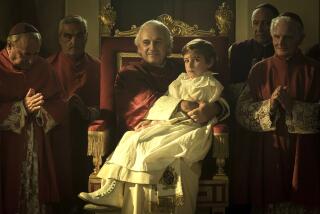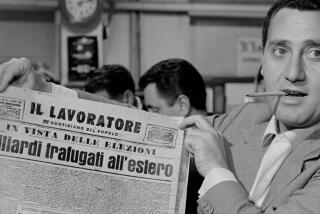Luchino Visconti’s ‘L’Innocente’ is a luscious stab to the heart of the aristocracy
- Share via
A version of this review originally ran in The Times on May 3, 1979, when the 1976 film was first released in the U.S. as “The Innocent.” The 2020 reissue is a digital HD restoration.
The late Luchino Visconti’s stately, sensual “L’Innocente,” freely adapted from an 1892 Gabriele D’Annunzio novel, proves to be a fitting and majestic finale to a remarkable career that embraced neorealism and period romanticism with a grand yet disciplined operatic style.
It was a visual style that at once expressed and resolved the director’s aristocratic background — he was in fact a count of ancient lineage — and his Marxist political leanings. It was Visconti’s special gift to be able to evoke privileged, often decadent worlds of great luxury and elegance just at the moment of their disintegration. The grand, fatal passions experienced by his people usually foreshadowed the larger historic and cataclysmic events about to overtake them.
This is especially true of “Senso” and “The Leopard,” both set against the time of the Risorgimento, and also of “L’Innocente,” which takes place at the height of La Belle Epoque, which was to be destroyed by World War I.
Giancarlo Giannini is a turn-of-the-century Roman aristocrat infatuated by his mistress (Jennifer O’Neill), a glamorous widow, and patronizing toward his wife (Laura Antonelli). However, O’Neill’s capriciousness and independence combine with the attraction Antonelli elicits in a young writer (Marc Porel) to rekindle Giannini’s passion for his wife. Just when he and his wife are experiencing ecstacies they have never known before, he learns from his mother (Rita Morelli) that his wife is pregnant. There is no way he could be the father.
The couple are then plunged into an emotional abyss, tormented by conflicted feelings of love and hatred. Their agony reflects the conventions and beliefs of their time and place, and for Visconti it is significant that they are members of that portion of Italian society most responsible for the rise of fascism.
Giannini’s miserable, jealous husband has been an avowed atheist and libertine, a man who attempts to disregard all that is held sacred in his world. Consequently, “L’Innocente” becomes a romantic tragedy, exquisitely modulated by Visconti and culminating on a note of horror (which Visconti effectively compounds in a departure from D’Annunzio).
As in all Visconti period pictures, “L’Innocente” has the most sumptuous settings and lavish costumes, designed by Mario Garbuglia and Piero Tosi, respectively, both distinguished, longtime Visconti collaborators. Pasqualino DeSantis’ camera gracefully captures all this incredible richness, and Franco Mannino’s score incorporates appropriately elegiac selections from Chopin, Mozart and Liszt.
“L’Innocente” is the kind of opulent, passionate drama that risks folly to attain the sublime. Giannini and Antonelli are equal to the challenge while O’Neill, who looks ravishing, provides a dispassionate counterpoint.
'L'Innocente'
In Italian with English subtitles
Not rated
Running time: 2 hour, 9 minutes
Playing: Starts Feb. 14, Laemmle Royal, West Los Angeles
More to Read
Only good movies
Get the Indie Focus newsletter, Mark Olsen's weekly guide to the world of cinema.
You may occasionally receive promotional content from the Los Angeles Times.







